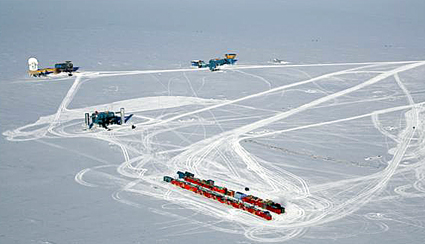Page 2/3 - Posted December 4, 2009
AMANDA experiment proved viability of IceCubeHe anticipates the next question. “When will we discover something?” he asks. “I don’t know,” he adds, laughing at his moment of self-reflection. “It’s not that I don’t care, but even if we don’t discover anything, it’s been so exciting.” Consider that it’s been 10 years since the proposal to build IceCube went through the peer-review gauntlet. Funds came from the National Science Foundation’s That’s when Halzen wrote the first paper on the idea of using Antarctic ice as a medium to ensnare neutrinos. Other physicists had been trying to use DOM-like instruments in water, including a group in Hawaii that almost succeeded with the Deep Underwater Muon and Neutrino Detector (DUMAND) Halzen figured the ice’s clear, inviolate nature would work better than the ocean, which is susceptible to storms and waves, as well as biological process that could interfere with the detector. (However, a Mediterranean-based detector like IceCube is also under construction today called ANTARES It then took about 10 years to make the now-famous AMANDA Halzen waxed eloquently about the event in an essay he wrote for the New York Academy of Science “At five in the morning on October 12, 1997, the diagram told us, a neutrino — one of nature’s smallest and most elusive elementary particles — had entered the earth in the middle of the Pacific Ocean, between Midway Island and the Aleutians, hurtled straight through the planet, and collided head-on with a proton on the underside of the Antarctic ice. Two kilometers beneath the surface, our grid of photomultipliers had picked up a subatomic spark from that collision as it flew upward through the ice and flared past them for about a microsecond.
“The end result, abstracted on a computer screen, would have seemed unremarkable to most people. But to us it was the sole trace of a particle that had traversed vast distances to reach us, perhaps a remnant of one of the most spectacular events in the universe. More to the point, it was the first concrete proof that AMANDA worked — that it could help map the distant depths of space, thereby perhaps resolving some of the most heated controversies in physics. Later, when I e-mailed the diagram to our collaborators, one of them wrote back: ‘This is why I’ve spent five years of my life on this project.’”
Halzen has devoted more than two decades of his life to chasing the elusive neutrinos through polar ice, with two years to go before the IceCube construction phase is complete. It’s only a matter of time at this point before the long struggle is over. It wasn’t always a fait accompli. “I thought this project was over many times over the last 20 years,” Halzen confides. The science is the relatively easy part. IceCube digitizes the signals from the high-tech DOMs, which makes it easier to analyze the data. In theory, Halzen could run the experiment from a laptop in his office. But technical glitches, software meltdowns, will always require a couple of people to be on the Ice even after the detector is finished in 2011. One of the biggest obstacles was the technology to construct the detector. Specifically, the challenge was building the hotwater drill, which burns a hole about 2.5 kilometers deep. The hose alone weighs more than 12,000 tons. It’s not something you find sitting on the shelf at the corner hardware store. “The drilling was the most exciting part, I must say. You realize that you don’t go buy a drill somewhere. Nobody builds that stuff. You can’t start your own business and do this. You have to go to experts and convince them,” Halzen explains.Back 1 2 3 Next |



For USAP Participants |
For The Public |
For Researchers and EducatorsContact UsU.S. National Science FoundationOffice of Polar Programs Geosciences Directorate 2415 Eisenhower Avenue, Suite W7100 Alexandria, VA 22314 Sign up for the NSF Office of Polar Programs newsletter and events. Feedback Form |


